What is the value of an email address?

Marketers are under a lot of pressure at the moment. Budgets are tight, channels are multiplying, and everyone’s chasing the same goals: drive sales, increase revenue, and improve customer lifetime value (CLV). But while 60% of marketing leaders are prioritizing increasing CLV, many still struggle to measure the ROI of one of their most profitable channels: email.
That’s surprising, because email is a long-standing part of the marketing mix. And, it’s a channel that, despite being told every year it’s no longer relevant, continues to thrive. According to Litmus, for every dollar spent on email marketing, marketers can get $36–$50 in return, so it’s no wonder global email marketing revenue is projected to hit $14.5 billion by 2026.
It’s safe to say email is still the MVP of marketing channels. The inbox is where customers want to engage. It’s personal, permission-based, and gives customers control over how they interact with brands.
Marketers clearly know the value of this channel, too. Brands scored the highest in the email marketing category in our latest Hitting the mark report, and it remains the preferred channel for consumers, according to our consumer research report, the loyalty divide. But while email continues to outperform other channels, many brands still aren’t tapping its full potential, especially when it comes to email list growth and long-term engagement.
An email address is the starting point of a relationship. It’s your invitation to deliver value, build trust, and set the tone for a long-term connection. Once you’ve earned that inbox spot, you unlock the ability to retarget, nurture, and delight your customers over time.
Need to know email marketing stats
- Email was the highest-scoring category in Hitting the mark, with brands averaging 16 out of 25, a clear sign that marketers recognize its power and potential
- For every $1 spent on email marketing, 35% of marketers see $10–$36 in return, 30% see $36–$50, and 5% earn more than $50
- Global email marketing revenue is projected to reach $14.5 billion by the end of 2026, proving that the channel still generates big business
- 60% of marketers said improving CLV is their top goal, while nearly 40% are focusing on increasing purchase frequency, with email playing a central role in achieving both
- Despite email’s proven results, 22% of marketers across major markets say proving ROI is still a major roadblock to success
- Around 24% of marketers say Tuesday is their go-to day for sending campaigns, with Thursday close behind at 20%
- When asked about their main objectives, 20% of marketers said generating leads was their primary goal, followed by 17% focused on nurturing subscribers with offers or lifecycle automation
- 40% of marketers say the most exciting use of AI right now is automatic content and image generation, opening the door to faster, more personalized campaigns
Why email list growth matters
But performance that delivers results doesn’t happen by accident. To get the most from your email marketing, you need to start the relationship strong and think about how to grow your list strategically. A strong list growth strategy doesn’t just fill your database; it lays the foundation for smarter automation, richer personalization, and lasting loyalty.
Yet, in our latest Hitting the mark report, only 45% of brands had a clear list growth strategy, using tools like popovers or attention-grabbing sign-up tactics. The remaining 55% buried their sign-ups in footers or hid them behind account creation. In other words, more than half of the brands are making it harder than it should be to kickstart a relationship with prospective customers, missing out on list growth opportunities.
And that’s a problem because if subscribing isn’t easy, most visitors won’t bother, and once they leave, that connection is lost.
The benefits of a strong email list growth strategy
Making it easy and enticing to subscribe creates a reliable way to boost CLV and build long-term loyalty. Plus, a well-planned email list growth strategy arms you with everything you need to deliver smarter automation, sharper personalization, and drive sustainable revenue growth.
A strong strategy can:
- Increase CLV: Engaged subscribers buy more often, spend more per purchase, and stay loyal longer, directly improving customer lifetime value
- Capture zero- and first-party data: Easily gather the insights you need to personalize campaigns, segment audiences, and even inform your broader marketing strategy
- Build trust and transparency: Set expectations from the first interaction by being clear about data use, consent, and the value exchange
- Enable smarter automation: Trigger personalized journeys that welcome, nurture, and convert new subscribers automatically
- Improve engagement rates: Deliver tailored content that feels relevant and timely, boosting open, click, and conversion rates
- Strengthen retention and loyalty: Turn new sign-ups into long-term brand advocates through consistent, value-driven communication
How to calculate the value of an email address
If you’re wondering whether it’s worth investing in your email list growth efforts, here’s a simple exercise to help you find out: calculate how much a single email address is worth to your business. Because when you can put a number to it (even a rough one), it becomes incredibly clear how powerful your acquisition efforts can be.
The value of one address
A single email address represents a relationship, a potential sale, and a share of your brand’s long-term revenue. To estimate what that relationship is worth, start with two numbers:
- Your total email-attributed revenue from the past 12 months
- The number of active subscribers (people who actually open, click, and convert — not your total list size)
Then use this simple calculation:
Email value per address = total email revenue ÷ active subscribers
Example: $20,000 ÷ 10,000 active addresses = $2 per subscriber(per year)
It’s a simple calculation, but it’s eye-opening. Even if that number seems small, it adds up fast when you think about the lifetime of that relationship.
The lifetime value of one email address
Now, let’s think about how long a subscriber typically stays active. If you lose around 5% of your list each month, your average subscriber lifespan is roughly 20 months (1 ÷ 0.05). Multiply your per-subscriber value by that number to get their lifetime value (LTV).
Lifetime value = Email value per address × average subscriber lifespan
Example: $2 × 20 months = $40 lifetime value per subscriber
Even if a single subscriber only contributes $2 a month, over time, they could be worth $40 to your brand. This number will increase the more they engage and when they make repeat purchases.
The value of your entire list
To get an even bigger picture, multiply that lifetime value by the number of active subscribers you have.
List value = lifetime value × active subscribers
Example: $40 × 50,000 active subscribers = $2,000,000 total list value
That’s the potential of your email list, which makes it worth thinking carefully about how to fill it with highly engaged subscribers.
How to grow your email list with engaged subscribers
Your email list growth strategy is about attracting the right people and giving them a reason to stick around. When you focus on quality, intent, and value exchange, you’ll build richer lists of engaged customers who love your brand.
Here’s how to build a list full of genuinely engaged prospects:
1. Get your placement right
Your sign-up form’s location can make or break your list growth efforts. If your only option to subscribe lives in the footer of your website, then you’re relying on visitors to scroll all the way down, which most won’t.
Think about where people are most engaged; every touchpoint is a chance to encourage email list growth. With 54% of consumers discovering new brands on mobile, the experience has to be quick and easy to act on. Popovers can work well, but they’re not the only way to get noticed. Try adding multiple touchpoints on your website, like banners, sticky headers, or embedded sign-up forms, to make subscribing feel seamless.
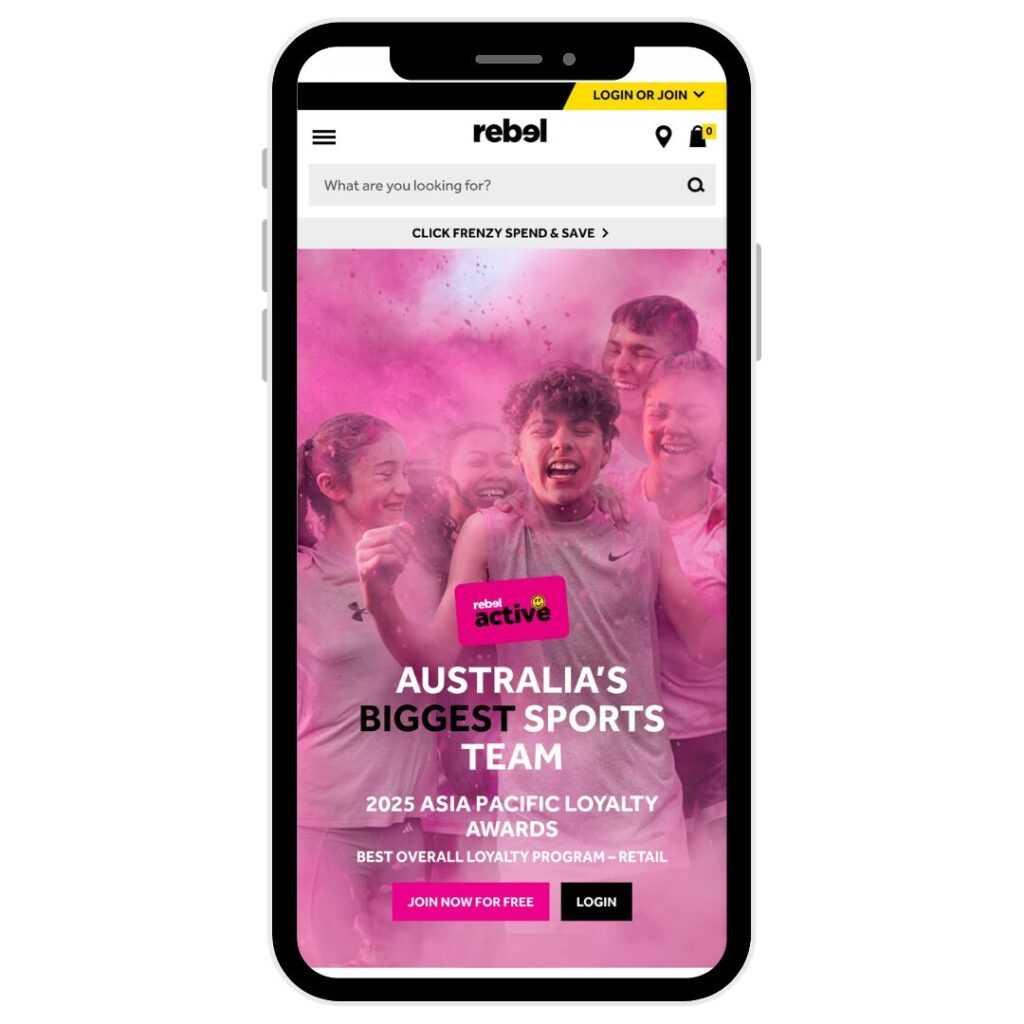
Activewear brand Rebel Active keeps a permanent sign-up CTA in its website header, making it easy to subscribe anytime. The homepage also promotes its loyalty program, giving visitors an extra reason to join.
2. Include clear consent and privacy messaging
Trust starts the moment someone shares their email with you, and it’s key to sustainable list growth. Yet in Hitting the mark, 32% of brands didn’t communicate their privacy policy or collect proper consent.
That’s not just risky, it’s a missed opportunity to build trust and confidence in your brand. Being upfront about how you’ll use a customer’s data and linking to your privacy policy shows transparency and respect.
Beyond being a legal must-have (in compliance with GDPR, CAN-SPAM, and various US state laws), this shows customers you value their data and won’t abuse their trust. With consumer confidence in data security at an all-time low because of recent and ongoing data breaches, this reassurance goes a long way in building relationships based on trust.
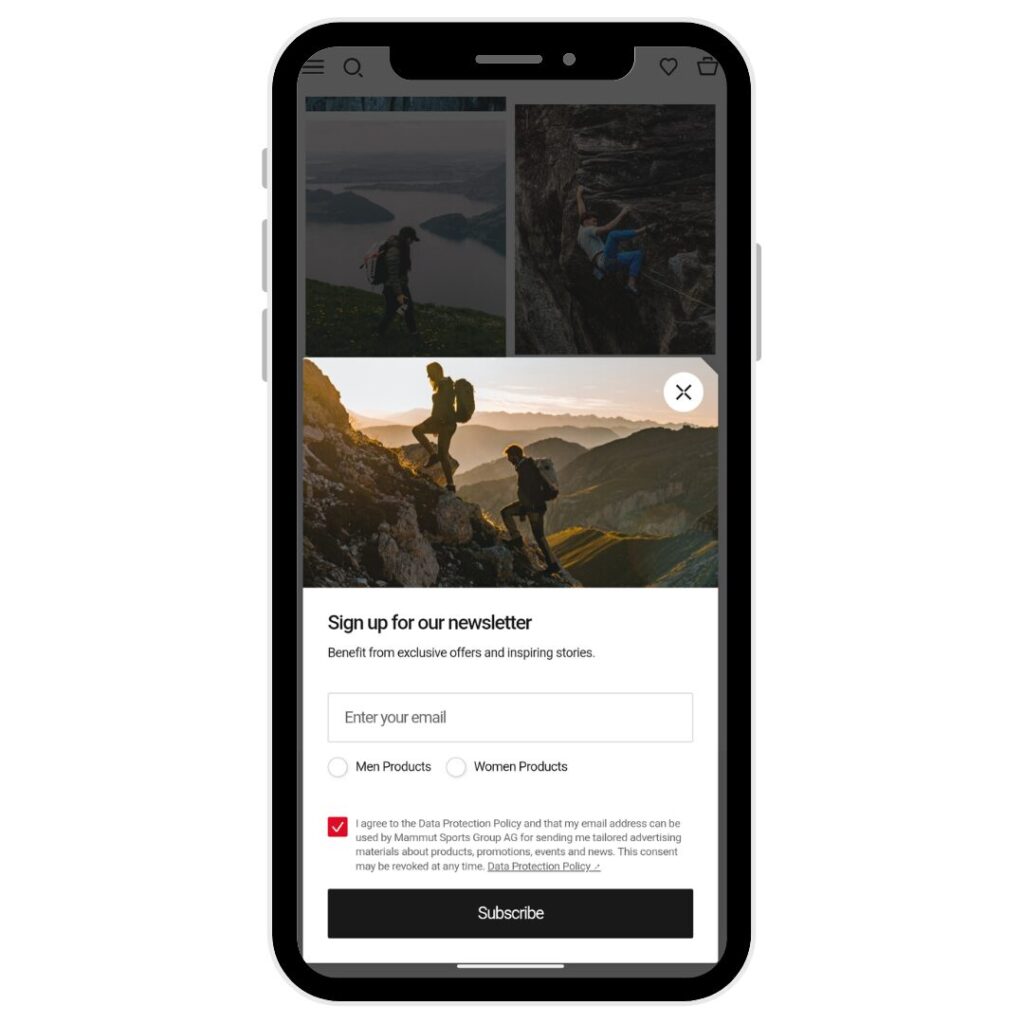
Mammut keeps its privacy and consent messaging short, clear, and customer-friendly. A simple tick box at the end of the form lets subscribers know exactly what they’re opting into, while a link to more details keeps things transparent without overwhelming the experience.
3. Use smart attention-grabbing tactics
Sign-up opportunities should adapt to where the visitor is in their journey. If you’re using popovers, make them contextual.
A few popover tactics you can try are:
- Delayed scroll popovers: Let visitors explore your homepage or landing page first, then invite them to subscribe halfway down the page
- Timed triggers: Show popovers after a set time period, like 45 seconds, to reach visitors who’ve clearly engaged or haven’t bounced
- Exit-intent prompts: Offer a light-touch “stay in touch” message before someone leaves your site
- Save your basket messages: Convert browsers who aren’t ready to buy yet but want to keep in touch
Just make sure you’re not overdoing it. Use conditions to avoid showing popovers to existing contacts, to avoid turning your helpful prompt into an annoyance.
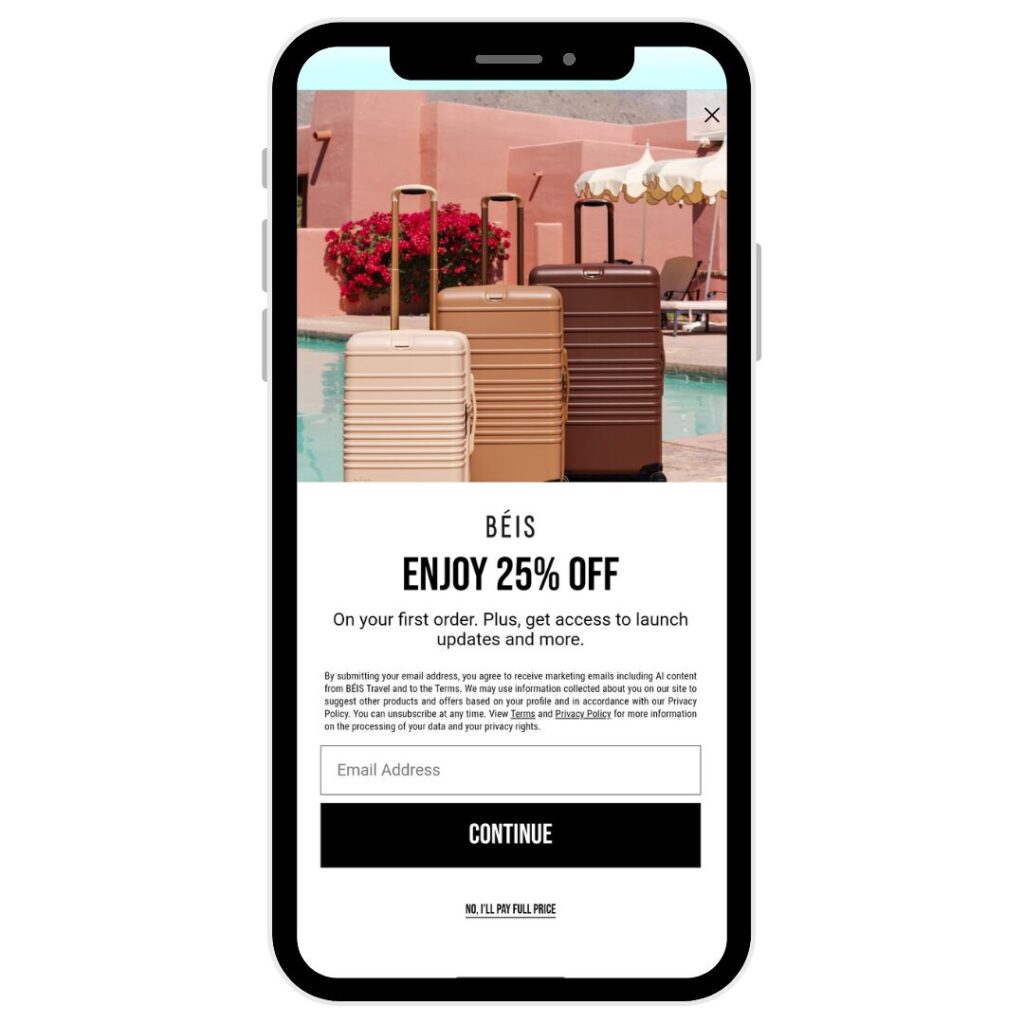
BÉIS uses a delayed popover to invite visitors to subscribe and sweetens the deal with a 25% discount. It’s a smart example of value exchange done well.
And remember, attention-grabbing doesn’t have to mean adding a popover to your site. If your website visits happen predominantly over mobile, popovers might not be ideal. Try using interactive tools like quizzes or style finders that collect valuable data in a fun, opt-in way. It’s engagement that doubles as insight.
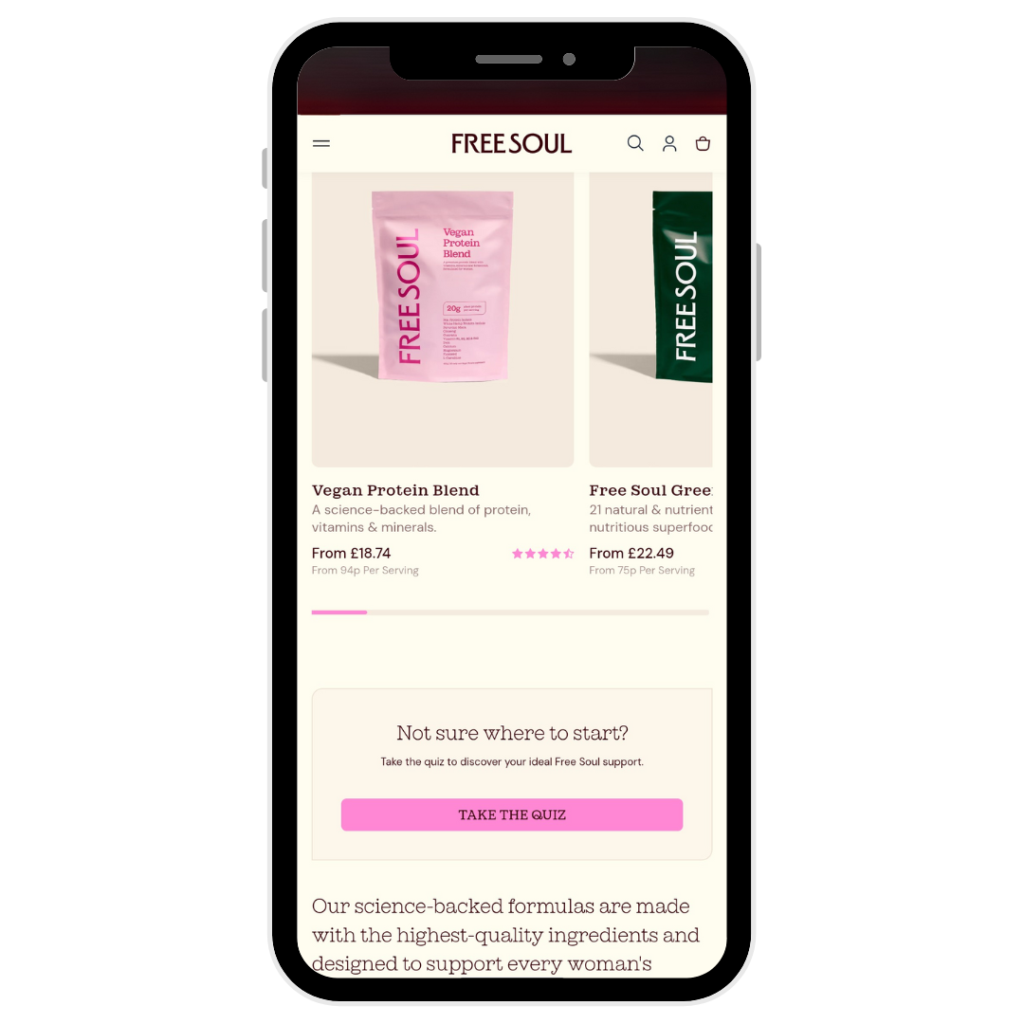
Health and nutrition brand Free Soul knows that choosing supplements can be confusing. To help, it offers an interactive quiz that delivers personalized product recommendations and collects valuable subscriber data in a natural, engaging way.
4. Be clear, open, and value-driven
The best-performing sign-ups are built on honesty. Tell customers what you’re collecting and why you’re collecting it.
Instead of saying “Tell us your birthday,” flip it to “Get a birthday treat from us.” Make the value exchange obvious to the subscriber. For every piece of data they share, they should feel like they’re getting something better in return. This small shift builds trust, reinforces transparency, and positions your brand as one that gives more than it takes.
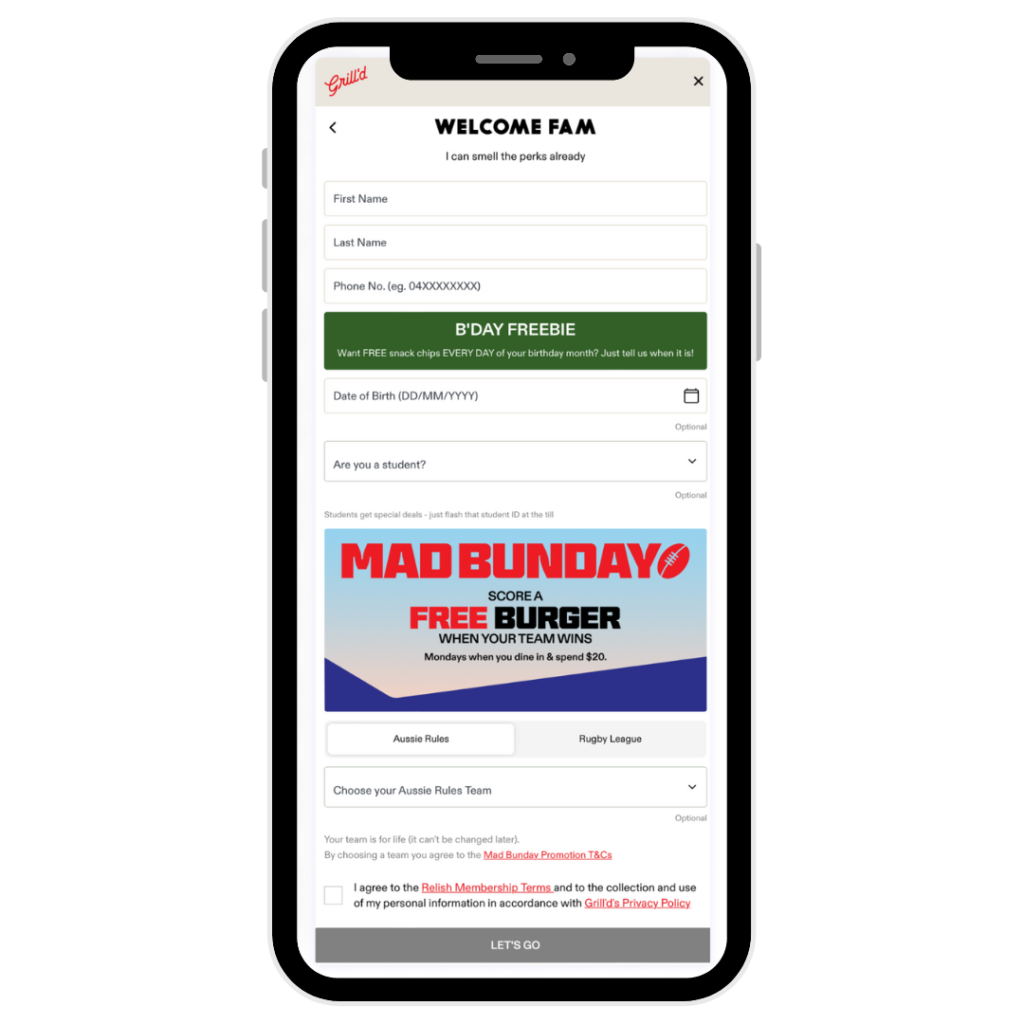
Grill’d makes data sharing irresistible by clearly explaining why they collect information like birthdays and favorite Aussie Rules teams, and what subscribers get in return. It’s transparent, relevant, and builds trust from the start of the relationship.
5. Weave loyalty into your sign-up experience
Loyalty isn’t the final stage of the customer journey; it should be your brand’s mindset that shows up right from the first interaction. Shoppers today expect to get something back for their engagement, and loyalty programs are a big part of that.
But according to Hitting the mark, only 22% of brands integrated loyalty or advocacy into welcome and onboarding messages, and just 9% had a fully integrated loyalty program across the entire customer journey.
If you have one, make it a feature of your sign-up experience. Position your loyalty or rewards program as a reason why visitors should subscribe. This shifts the mindset from “giving your email away” to “joining something valuable.”
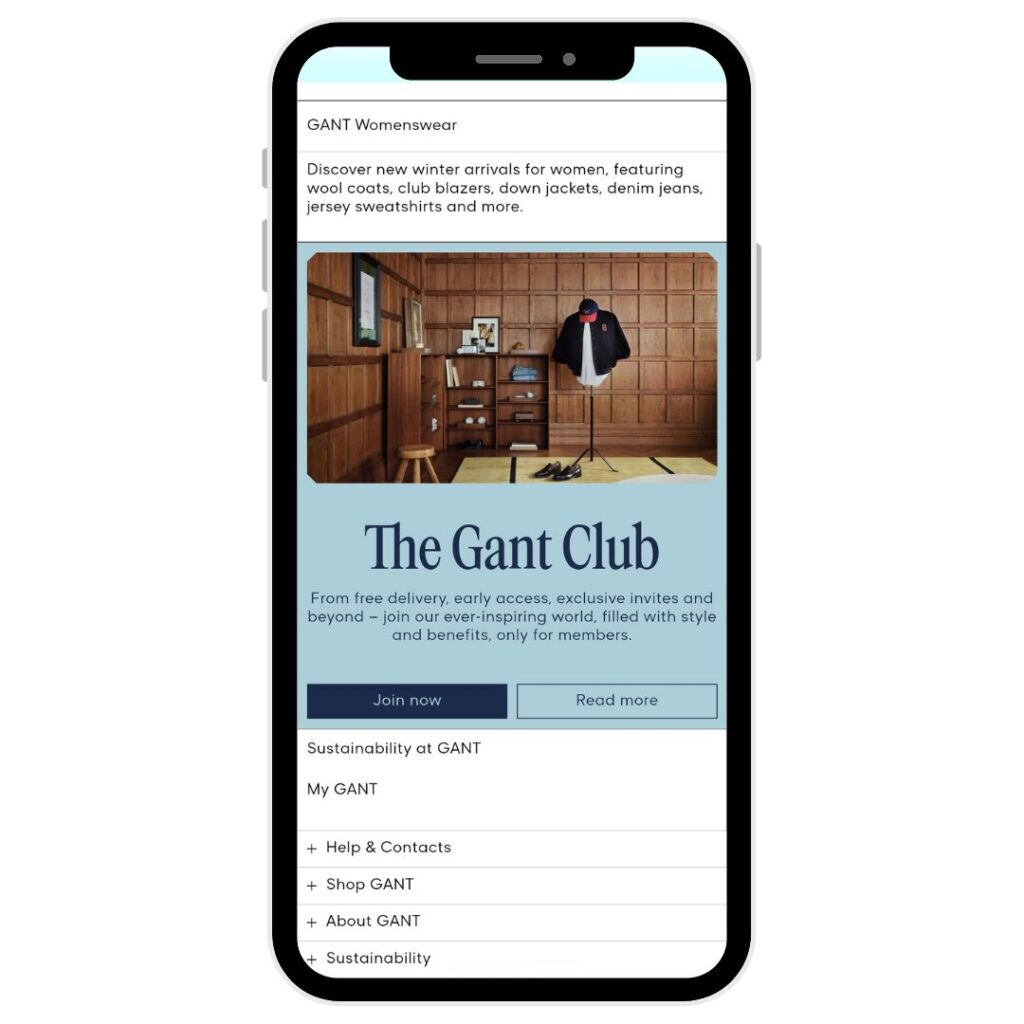
GANT takes a loyalty-first approach to list growth, shifting the message from “Sign up to our emails” to “Join the club.” This subtle change makes subscribing feel like joining an exclusive community, which sparks instant engagement and long-term loyalty.
Strong lists build stronger brands
Your email list is one of your most valuable marketing assets, but only if it’s full of people who genuinely want to hear from you. Keep focusing on meaningful list growth, quality data, and transparent value exchanges, and the ROI will follow naturally. When you treat list growth as an ongoing strategy, not a one-time task, your inbox becomes one of the most powerful drivers of loyalty and revenue your brand has.



